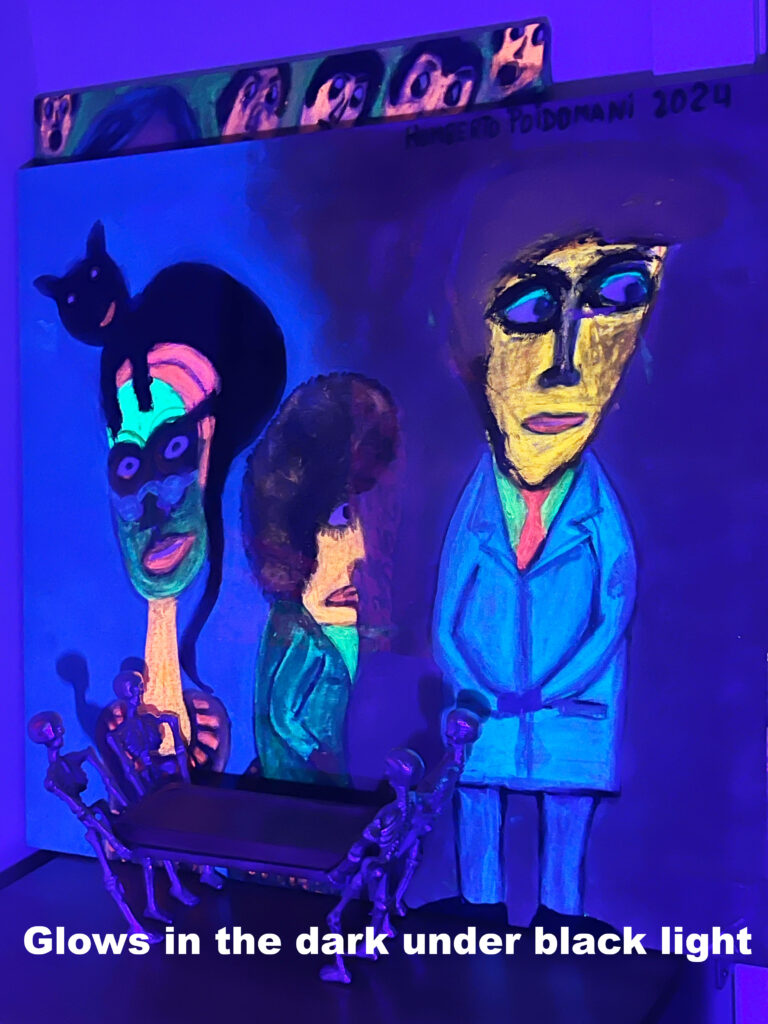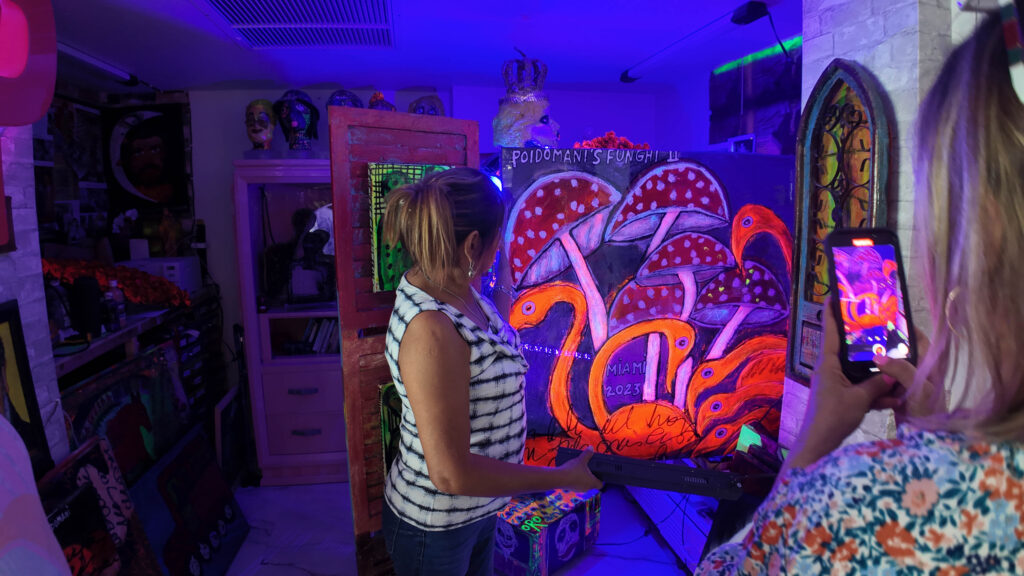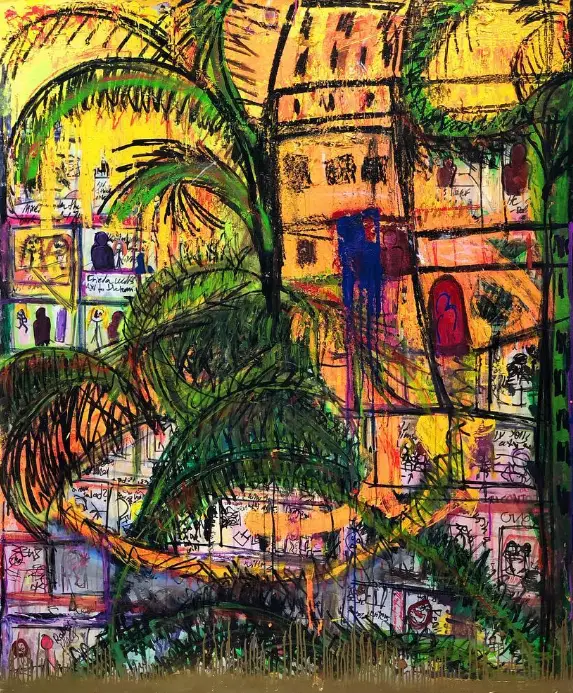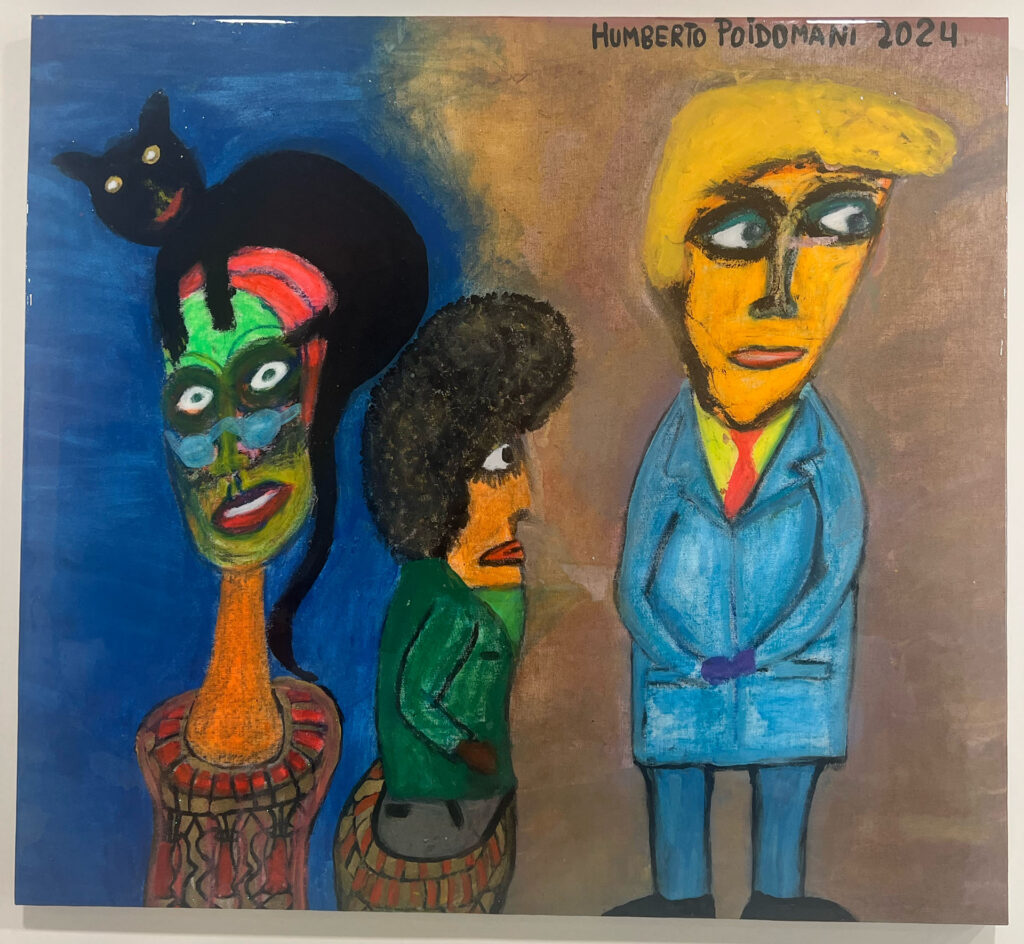لا يزال فن الضوء الأسود، وهو نوع فني آسر يمزج بين الفن والعلم، يأسر عشاق الفن المعاصر وجامعي الأعمال الفنية ومصممي الديكور الداخلي على حد سواء. باستخدام الأشعة فوق البنفسجية (الأشعة فوق البنفسجية) يُظهر فن الضوء الأسود طبقاتٍ خفية من الطلاء الفلوري، ويُحدث تأثيراتٍ آسرةً تُحوّل المساحات الحديثة والمعاصرة. سواءً كان ذلك توهج اللوحة النابض بالحياة أو التفاعل الديناميكي بين الضوء والظل، فإن هذا الشكل الفني يفتح آفاقًا فريدةً لهواة جمع الأعمال الفنية والفنانين المعاصرين لاستكشافها.
مع تزايد الطلب على الفن المبتكر والغامر، يُضفي فن الضوء الأسود جاذبية جمالية وفرصة قيّمة للاستثمار الفني، لا سيما لدى فنانين معاصرين من الأرجنتين، مثل هومبرتو بويدوماني، الذين يستخدمون هذه الوسيلة لنقل رسائل أيديولوجية واجتماعية أعمق. في هذه المقالة، سنتعمق في علم فن الضوء الأسود وتاريخه وتطبيقاته المحتملة، موضحين كيف يُمكنه أن يُضفي جمالاً على المساحات الحديثة، وفي الوقت نفسه يُمثل مورداً قيّماً لهواة جمع الأعمال الفنية.
فهم فن الضوء الأسود والضوء الفلوري
في جوهره، يعتمد فن الضوء الأسود على الأشعة فوق البنفسجية لإضاءة مواد معينة تحتوي على أصباغ فلورية. تُصدر الأضواء السوداء، التي تعمل عادةً في طيف الأشعة فوق البنفسجية-أ (320-400 نانومتر)، توهجًا أرجوانيًا لا تراه العين البشرية، ولكنه يُسبب انبعاث الضوء المرئي من المواد الفلورية. هذا التفاعل هو المسؤول عن التأثير المتوهج الذي يُميز فن الضوء الأسود.
تمتص الأصباغ الفلورية، كتلك الموجودة في الدهانات الأكريليكية المصممة خصيصًا، الأشعة فوق البنفسجية وتعيد إصدارها كضوء مرئي. غالبًا ما تحتوي هذه الأصباغ على الزنك. كبريتيد أو كبريتيد الكادميوم، المواد الكيميائية التي خلق تأثيرات متوهجة تُشاهد في العديد من تركيبات الضوء الأسود. عندما يصطدم الضوء الأسود بالطلاء الفلوري في العمل الفني، تبرز مناطق معينة، مما يُحدث تباينًا حادًا مع المناطق غير الفلورية.
في حين أن فن الضوء الأسود له جذوره في حركات الفن المخدر في ستينيات القرن العشرين، فقد تطور منذ ذلك الحين إلى أداة ديناميكية للفنانين المعاصرين الذين يجربون الضوء واللون والملمس.
السياق التاريخي لفن الضوء الأسود: من الفن المخدر إلى المعاصر
اكتسب فن الضوء الأسود شعبية واسعة خلال منتصف القرن العشرين، وخاصةً خلال حركة الفن المخدر، عندما سعى الفنانون إلى ابتكار تجارب فنية مذهلة ومحفزة بصريًا. كانت هذه فترة تجريبية، أضاءت خلالها تركيبات الضوء فوق البنفسجي الجداريات والكتابات الجرافيكية النابضة بالحياة، مما أضفى على الأعمال الفنية طابعًا سرياليًا يكاد يكون أشبه بالحلم. بدأ فن الشارع المخدر والجداريات الضخمة. لدمج عناصر الضوء الأسود، مما يدفع حدود ما يمكن للفنون البصرية تحقيقه.
التقدم السريع إلى اليوم، يواصل الفنانون المعاصرون استكشاف إمكانات فن الضوء الأسود، مستخدمين إياه في المعارض والمنشآت الفنية، وحتى في المجموعات الخاصة. يدمج الفنانون المعاصرون، مثل الأرجنتينيين، هذه التقنية في أعمالهم، متجاوزين بذلك جذورها السايكدلية، ومثبتين إياها في عالم الفن الحديث.
أحد هؤلاء الفنانين هو Humberto Poidomaniبويدوماني، فنان معاصر أرجنتيني مشهور، يُعرف باستخدامه المبتكر للمواد المكتشفة والمواضيع الأيديولوجية. غالبًا ما تتعمق أعمال بويدوماني في مواضيع الأزمات الاجتماعية والانحلال والتدهور البيئي. يُضفي دمج عناصر الضوء الأسود في منحوتاته ومنشآته الفنية عمقًا إضافيًا، مُبرزًا جوانب الحياة العصرية الخفية أو المنسية. يُعدّ عمل بويدوماني مثالًا رائعًا على قدرة فن الضوء الأسود على الارتقاء بالمنشآت الفنية المعاصرة، مُشركًا الجمهور بصريًا وفكريًا.
كيف يُمكن لفن الضوء الأسود أن يُزيّن المساحات المعاصرة
بالنسبة لمصممي الديكور الداخلي، يُقدم فن الضوء الأسود طريقة جريئة ومبتكرة لتزيين المساحات الحديثة والمعاصرة. يُضفي التوهج المضيء والدرجات اللونية المتغيرة تحت الضوء الأسود لمسةً حيويةً على أي غرفة، سواءً كانت مكتبًا بسيطًا أنيقًا أو غرفة معيشة نابضة بالحياة.
بوضع لوحة أو تركيب فني بإضاءة سوداء في مساحة محايدة، يمكن للمصممين خلق تباين مذهل يجذب الانتباه ويخلق نقاطًا محورية داخل الغرفة. تتفاعل هذه الأعمال الفنية مع الإضاءة العادية والأشعة فوق البنفسجية، مما يخلق تجربة مزدوجة للمشاهدين. على سبيل المثال، خلال النهار، قد تبدو لوحة بإضاءة سوداء كعمل فني أكريليك عادي.، ولكن عندما حلول الليل و يتم تشغيل أضواء الأشعة فوق البنفسجية، وتصبح الصبغات الفلورية حية، مما يحول العمل الفني إلى قطعة مركزية متوهجة وخفيفة.
هذه الثنائية تجعل فن الضوء الأسود متعدد الاستخدامات مجموعة واسعة من في بيئات متنوعة، من المساحات السكنية الحميمة إلى المنشآت التجارية الضخمة. في المعارض الفنية والعامة، يُستخدم فن الضوء الأسود غالبًا لخلق بيئات غامرة تتحدى إدراك المشاهد، وتدعوه للتفاعل مع العمل الفني بطريقة بصرية وعاطفية.
الاستخدام الجمالي والأيديولوجي في الفن المعاصر
لا يقتصر فن الضوء الأسود على الجاذبية البصرية فحسب، بل ينقل أيضًا معانٍ رمزية أعمق. يستخدم فنانون مثل هومبرتو بويدوماني الضوء الأسود لإبراز التباين بين ما هو مرئي وما هو خفي، تمامًا كما تُخفي القضايا المجتمعية غالبًا. في أعمال بويدوماني، قد ترمز عناصر الأشعة فوق البنفسجية المتوهجة إلى الانحلال المجتمعي أو الإهمال البيئي. في الوقت نفسه، تُمثل المناطق المظلمة غير الملموسة القضايا غير المرئية والمُلحة.
بالنسبة للفنانين المعاصرين، يُقدّم فن الضوء الأسود وسيلةً فريدةً للتعبير عن التوترات الأيديولوجية. يُمكن لتوهج الأصباغ الفلورية أن يُجسّد... اعتاد على تُجسّد هذه الأعمال هشاشة الحياة، وطبيعة الوجود الإنساني الزائلة، أو التناقض الصارخ بين الرخاء والفقر. وبينما يكشف الضوء الأسود عن الجوانب "الخفية" للعمل الفني، فإنه يدعو المشاهدين إلى التأمل فيما قد يكون مخفيًا في المجتمع.
استثمارات الفن وفن الضوء الأسود
مع احتضان عالم الفن بشكل متزايد للأعمال التفاعلية والمتعددة الوسائط، يوفر فن الضوء الأسود فرصة مثيرة لـ جامعي الفن و art المستثمرينإن حداثة هذا الشكل الفني، إلى جانب تعقيداته التقنية والجمالية، يمكن أن تزيد من قيمة القطع، خاصة إذا تم إنشاؤها بواسطة فنانين مشهورين مثل بويدوماني، المعروفين بتجاوز الحدود الفنية.
يتطلب الاستثمار في فن الضوء الأسود مراعاة التأثير البصري والحفاظ عليه على المدى الطويل. فرغم أهمية الأشعة فوق البنفسجية في كشف العناصر الفلورية، إلا أنها قد تُسبب تدهورًا في بعض الأصباغ والمواد مع مرور الوقت. وهذا يُشكل تحديًا لكل من الفنانين وجامعي الأعمال الفنية فيما يتعلق بالحفظ. وللحفاظ على قيمة العمل الفني، يجب على هواة الجمع التأكد من عرض القطع في ظروف إضاءة مُتحكم بها وحمايتها من التعرض المُطول للأشعة فوق البنفسجية. وتضمن حماية المواد الحساسة للأشعة فوق البنفسجية والحفاظ عليها استمرارية استثماراتهم الفنية في تحقيق متعة بصرية اليوم وأمنهم المالي في المستقبل.
بالنسبة للمستثمرين الذين يتطلعون إلى تنويع محافظهم الاستثمارية، يُمثل اقتناء أعمال فنية من فنانين معاصرين، وخاصةً القادمين من مناطق مثل الأرجنتين، فرصةً فريدة. فنانون مثل بويدوماني، المشهود لهم عالميًا، في وضعٍ يُتيح لهم رؤية أعمالهم تُقدّر مع مرور الوقت، مما يجعلهم خيارًا مثاليًا للمستثمرين الفنيين المخضرمين والجدد على السوق.
الضوء الأسود في المعارض والأماكن العامة
تدمج المتاحف والمعارض الفنية بشكل متزايد فن الضوء الأسود في معارضها، مستخدمةً إياه لخلق تجارب غامرة ومتعددة الأبعاد. عند عرض قطع مختارة تحت الأشعة فوق البنفسجية، يتفاعل المشاهدون مع العمل الفني بشكل مختلف، مما يعزز استجابتهم العاطفية ويشجع على تفاعل أعمق. تضفي عناصر الضوء الأسود حيوية على العمل الفني، مضيفةً طبقات لا تظهر إلا في ظروف إضاءة محددة.
يمكن لفن الضوء الأسود أن يضفي شعورًا بالدهشة والتشويق على الأعمال الفنية العامة. على سبيل المثال، تنبض الجداريات الحضرية، التي تستخدم أصباغًا حساسة للأشعة فوق البنفسجية، بالحياة ليلًا، محولةً أعمالًا فنيةً جامدةً إلى عروض متوهجة تتفاعل مع البيئة المحيطة. في الأعمال الفنية الخارجية الكبيرة، يُبرز الضوء الأسود عناصر معمارية محددة أو يعزز التفاعل بين الضوء الطبيعي والعمل الفني، مما يخلق شعورًا بالحركة والانسيابية.
قضايا الحفظ والمحافظة
في حين أن التأثيرات البصرية لفن الضوء الأسود مذهلة، إلا أنها تأتي مع تأكيد تحديات الحفاظ على البيئة. يمكن للأشعة فوق البنفسجية أن تتسبب في تدهور المواد، وخاصة الأصباغ العضوية، بمرور الوقت. بالنسبة للفنانين والجامعين، يعني هذا إيجاد طرق لحماية القطع من التعرض المفرط للأشعة فوق البنفسجية مع الحفاظ على البيئة. لا يزال يسمح بذلك العناصر التفاعلية للتألق.
بالنسبة لجامعي الأعمال الفنية والمستثمرين، يتضمن هذا التأكد من تخزين القطع وعرضها في بيئات ذات تعرض مباشر لأشعة الشمس فوق البنفسجية إلى الحد الأدنى. إن استخدام الزجاج أو الأكريليك المرشح للأشعة فوق البنفسجية في التأطير وتجنب الاستخدام المفرط للأشعة فوق البنفسجية سيساعد في إطالة عمر الأعمال الفنية ذات الضوء الأسود، مما يضمن بقائها استثمارات قيمة لسنوات.
خاتمة
في الختام، يعمل فن الضوء الأسود على تعزيز المساحات المعاصرة بشكل فريد، حيث يسد الفجوة بين العلم والفن والأيديولوجية. بالنسبة لمصممي الديكور الداخلي وعشاق الفن المعاصر، فإن دمج قطع الضوء الأسود في المساحات الحديثة يمكن أن يخلق تجارب ديناميكية وغامرة تحول العادي إلى غير عادي. الفنانين، مثل هومبرتو بويدوماني من الأرجنتين، يعمل فن الضوء الأسود كأداة لنقل أعمق الرسائل المجتمعية، في حين جامعي الفن و المستثمرينتقدم هذه الأعمال فرصًا واعدة للتقدير الجمالي والنقدي. الاستثمارات الفنية.
بفضل تأثيره البصري الجريء وعمقه الرمزي، يستعد فن الضوء الأسود لمواصلة جذب الجماهير ودفع حدود الفن المعاصر إلى آفاق جديدة. وسواء عُرض في مجموعة خاصة أو في مكان عام أو معرض تجاري، فإن هذا النوع من الفن يفتح إمكانيات جديدة للتعبير الفني والاستثمار في العالم الحديث.
اتجاهات الفن لعام ٢٠٢٤ وما بعده: دور فن الضوء الأسود في المستقبل
ونحن نتطلع إلى الأمام اتجاهات الفن 2024يبرز فن الضوء الأسود كعنصر أساسي في عالم الفن الغامر والتفاعلي. بمزيجه الآسر من الأصباغ الفلورية والأشعة فوق البنفسجية، يتماشى هذا النوع من الفن مع الطلب المتزايد على الفن الذي لا يزين المكان فحسب، بل يحوله أيضًا إلى تجربة آسرة. اتجاهات الفن 2025 ومن المقرر أن تدفع هذه المشاريع حدود التركيبات المعتمدة على الضوء إلى أبعد من ذلك، حيث سيصبح استخدام الضوء الأسود في المعارض الفنية والمجموعات الخاصة مطلوبًا بشكل متزايد نظرًا لقدرته الفريدة على الكشف عن الطبقات والمعنى المخفي في العمل الفني.





